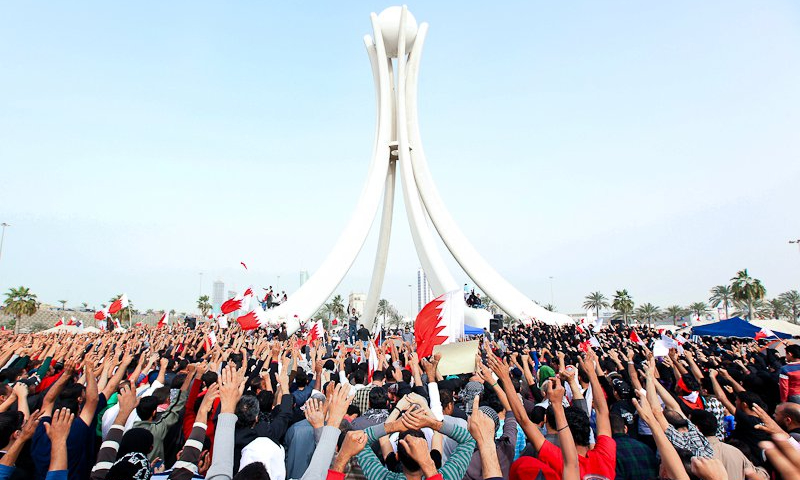Heavy Lies the Crown: The Survival of Arab Monarchies, 10 Years After the Arab Spring
Monarchs escaped the uprisings relatively unscathed, but now face mounting problems and are turning to more repressive policies to limit dissent.

Published by The Lawfare Institute
in Cooperation With

Editor’s Note: This article originally appeared on Order from Chaos.
Ten years ago, the Arab uprisings unseated four “presidents for life” in Tunisia, Libya, Egypt, and Yemen. The Middle East and North Africa’s (MENA) eight monarchs were spared, although many of their countries experienced moderate or significant unrest, including Bahrain, Saudi Arabia, Kuwait, Oman, Jordan, and Morocco. The United Arab Emirates (UAE) and Qatar faced the least contestation of the monarchies.
Since then, scholars have asked what it means that no monarch was overthrown and whether Arab monarchy matters to the outcome of regime survival. Various experts have linked the latter to monarchs’ legitimacy, external support, and resource wealth. Though there is no consensus, it is clear that monarchs have repeatedly and successfully contained different types of opposition threats for decades prior to the Arab Spring and continue to do so 10 years later.
Today the question of Arab monarchical survival remains highly relevant. Since the 2011 uprisings, protests erupted across Jordan, Morocco, Bahrain, Saudi Arabia, Oman, and Kuwait. They were usually triggered, at least in part, by economic hardship, which suggests that protests will continue, especially given the economic consequences of the coronavirus pandemic. Worryingly, across the board, Arab monarchs have increasingly repressed critics and opposition actors. In extreme cases, regimes have resorted to assassination and torture; in others, they have used judicial proceedings and long prison sentences to constrain dissidents.
As popular discontent grows due to heightened repression and persistent economic woes, further contestation will likely take place in many of these cases. However, Arab monarchs may find that their usual containment strategies will prove less effective as populations and opposition movements transform, and that the time has come for them to adapt their behavior.
The Monarchs’ Spring
Arab Spring-related protests across the monarchies were broadly triggered by a combination of economic, social, and political factors. For example, in Saudi Arabia, where unrest was catalyzed by the self-immolation of an elderly man due to poor living conditions, people protested economic hardship, anti-Shia discrimination, and the constrained political scene. The most significant unrest occurred in the oil-producing, Shia-populated Eastern Province whose residents repeatedly took to the streets because of marginalization, inequality, and repression.
In oil-rich Kuwait, citizens sought a more representative political system and reforms that would reduce the emir’s powers, notably through the legalization of political parties. In economically vulnerable monarchies like Jordan, Morocco, and Oman, unrest was triggered by high unemployment rates, planned subsidy reforms, and soaring food and fuel prices. Protesters also sought constitutional reforms, better electoral laws, transparent elections, and stronger legislative branches. The UAE and Qatar experienced very limited unrest. Around 150 Emiratis organized a petition asking for greater political opening through universal suffrage and a more powerful Federal National Council. In Qatar, there were no petitions nor protests; however, shortly after the Kuwaiti regime announced it would provide citizens with a total of $4 billion in handouts, Qatari nationals demanded a similar package, according to local sources.
At the other end of the spectrum, Bahrain experienced the most unrest, as protests that initially sought political opening and equality for the Shia majority escalated due to the regime’s use of excessive force. In fact, Bahrain was the only monarchy where the protest movement called for the abdication of the ruling family. Brutal violence triggered more protests, which led to further repression. This loop eventually intensified, and the Bahraini monarchy requested and obtained military aid from its neighbors to contain the situation.
Surviving the Arab Spring
Most Arab monarchs attempted to contain the 2011 uprisings in a broadly similar manner: They granted monetary incentives and limited political concessions, which they combined with repressive tactics that constrained persistent protesters and deterred further contestation. Of course, depending on regime wealth and type, some offered more concessions or repressed protesters more harshly than others.
Indeed, Arab monarchies can be categorized according to their political systems and economic conditions. Broadly, there are the poorest kingdoms—Morocco and Jordan—and the relatively wealthier Gulf monarchies. The latter group can be further divided into three categories: super-rentier states with small populations and high reserves of natural resources (Kuwait, Qatar, and the UAE), an oil-wealthy kingdom with a significantly larger population (Saudi Arabia), and the economically vulnerable Gulf monarchies (Oman and Bahrain).
Their political systems range from absolute monarchy to soft dictatorships. Morocco and Jordan fit the latter description; they have both a minimum component of democracy and mechanisms that ensure the ruler remains the most powerful actor. Although Kuwait and Bahrain have minor openings and developing civil society groups, Gulf monarchies overall have more restrictive political systems compared to Morocco and Jordan.
These categorizations help explain how regimes interact with populations and opposition movements. Wealthier monarchies can provide citizens with material perks in a way that poorer monarchies cannot. During the uprisings, while poorer monarchies like Morocco and Jordan offered modest monetary concessions like delayed austerity measures and increased subsidies, super-rentier states such as the United Arab Emirates could afford multi-billion-dollar development projects. Furthermore, monarchies with strong civil society and political groups face greater or more frequent opposition than absolute monarchies and are less likely to harshly repress them. This partly explains why security forces in Bahrain and Saudi Arabia killed a massive number of protesters compared to in Morocco and Jordan.
Yet, most Arab monarchs contained the 2011 uprisings by granting monetary and political concessions as well as repression. Notably, the Saudi regime promised to spend $130 billion to increase salaries, build housing, and undertake other projects. The UAE pledged $1.6 billion for infrastructure projects in the poorer northern emirates. The Bahraini regime pre-emptively granted every Bahraini family $2,600 in cash handouts, while the Kuwaiti regime provided all citizens with $3,500. Qatar increased public sector wages for nationals by 60 percent. Austerity measures were delayed in Jordan, Morocco, and Oman. Saudi Arabia, Bahrain, Oman, and Jordan promised to create tens of thousands of public sector jobs. Subsidies were increased or introduced in Morocco, Saudi Arabia, the UAE, and Kuwait.
In terms of political concessions, Arab monarchs granted limited reforms that minimally constrained them while addressing some of the opposition’s demands. In Qatar, the regime pre-emptively announced elections for the legislative body (thus far postponed) and laws in favor of separation of powers. Deeper constitutional reforms were carried out in Jordan, Morocco, and Oman. New elections were announced in Saudi Arabia, Morocco, and Jordan. Rulers reshuffled cabinets, dissolved parliaments, or dismissed government officials targeted by protesters in Kuwait, Jordan, and Oman. New electoral laws were created in Saudi Arabia, the UAE, Jordan, and Morocco. The reforms sought to appease protesters and contain the threat of the uprisings, not to democratize or genuinely open the political sphere. In most cases, the disingenuousness of these reforms triggered further protests later, which were immediately repressed.
Overall, repression was used not excessively like in Bahrain, but rather as a supplementary tool aiming to ensure that protesters accepted concessions and to deter further protests. Protesters were arrested across the board, and freedoms were constrained thereafter. In Kuwait, stateless Bidoon protesters were either ignored or threatened with deportation. In Saudi Arabia, where the regime increased the presence of security forces at the onset of the protests, Shia protesters in the Eastern Province were targeted more than Sunni protesters. In many of these monarchies, activists who criticized the regime following the uprisings were imprisoned.
After the Spring
Despite hopes that the uprisings would bring greater political opening to these kingdoms, Arab monarchs have not fulfilled most promises of liberalization. The ensuing popular disillusionment with these regimes—combined with economic hardship, inequality, and corruption—led to repeated episodes of contestation since 2011.
In Bahrain, protests re-erupted, ranging from large demonstrations—such as in March 2012, attended by around 100,000 people—to smaller-scale rallies like on February 14 of this year. Security forces and protesters clashed repeatedly between 2011 and 2020. Most of these protests were peaceful, but all were met with brutal repression, including torture, beatings, arrests, tear gas, live ammunition, and intimidation. Authorities also blocked access to the internet, raided schools, and arrested and charged medical workers who had treated protesters.
In the other less extreme cases, freedoms and the space for contestation were greatly restricted after 2011. Monarchies such as Kuwait and Oman adopted new, more restrictive laws. Activists and protest organizers were imprisoned in Saudi Arabia, Oman, and Morocco. There have been reports of torture in Saudi Arabia. Police forces used beatings, tear gas, or water cannons against protesters in Jordan. The Saudi regime repressed repeated dissent in the Qatif region between 2017 and 2020. It also implemented a two-year purge of prominent business and political figures, carried out a crackdown against feminists between 2018 and 2019, and is widely believed to have orchestrated the murder of Saudi journalist Jamal Khashoggi.
Jordan saw major protests between 2016 and 2020. Most were triggered by economic issues—namely unemployment, austerity measures, and reduced spending—though in a few instances, protesters did call for political reform like rallies in 2018. That same year, a new tax law and International Monetary Fund-imposed austerity measures sparked several general strikes, which escalated to a series of country-wide protests. Though smaller in scale, similar protests followed in 2019 and 2020. Most were peaceful, yet were met with a harsh security response, including pre-trial detentions, home raids, the dissolution of unions, arrests, and harsher internet laws.
In Oman, youth groups took to the streets in 2018 and 2019 to demand jobs and were arrested, beaten, or dispersed. Authorities cracked down on Bidoon protesters seeking Kuwaiti citizenship rights in 2019. Morocco saw an unprecedented boycott in 2019 as well as a series of protests in Jrada, Errachidia, and Rif, with unrest in the latter escalating to country-wide demonstrations against economic marginalization, corruption, and repression. Along with some concessions, protests were met with a strong security response. More widely, freedom of expression has been more restricted in recent years.
Outlook: A Time for Change
Lessons of monarchical survival during and since the Arab uprisings show that monarchs, like all rulers, are opportunistic. To avoid overthrow and maintain power, they use containment and deterrence strategies involving some combination of repression, public spending, and conciliatory steps. Importantly, they have strategically adapted over the years; today, most monarchs know that they are constrained by historical context. They face pressure to use brutal force more sparingly than their predecessors to avoid domestic and international backlash. Instead, they resort to political maneuvering, smear campaigns, and judicial repression.
Opposition actors and populations also learn from regime behavior, modify their actions to promote their interests, and adapt to changing contexts. In Jordan, this meant threatening a possible escalation to a mass revolution to obtain concessions from the regime. In Morocco, new forms of contestation, such as a country-wide boycott, were adopted that avoided traditional repressive tactics. In Oman, silent protests were carried out to express discontent in a country that traditionally has little space for contestation. Importantly, the more regimes repress and the more they renege on promises of liberalization, the more disillusioned populations grow and the less likely they are to accept such promises in the future.
In other words, while they have been successful in the past, these tried-and-true strategies of threat containment will likely become gradually less effective as opposition movements evolve and populations transform. Furthermore, regimes’ heightened use of repression is not sustainable and can lead to backlash. In time, these regimes’ unfulfilled promises of reform and development will catch up with them, and they will have to adapt the ways in which they interact with opposition actors and their wider populations, especially as further and greater contestation is imminent.





